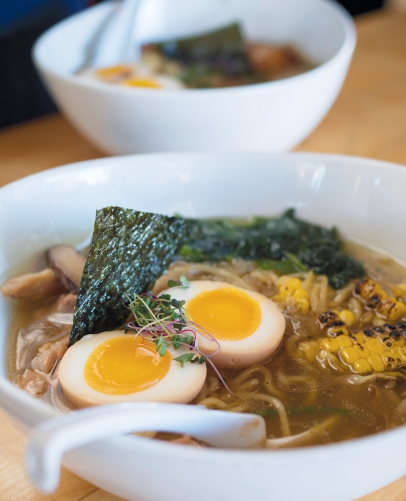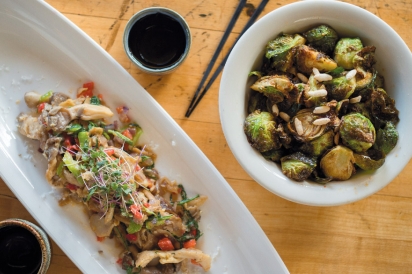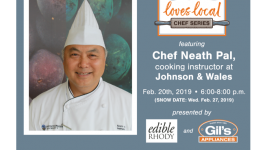Unlocking the Fifth Taste
Experiencing Deliciousness Over Two Bowls of Ramen
Two steaming bowls of ramen, a plate of assorted sautéed exotic mushrooms, a bowl of crispy Brussels sprouts dressed in citrus soy and fish sauce and a platter of takoyaki topped with bonito flakes—all guaranteed to deliver an immersive umami experience with every bite.
The point of this veritable feast of umami-rich foods was to gain a better understanding of umami—or what is called the fifth taste, along with sweet, sour, bitter and salt, which, combined, make up the five tastes detected by the human tongue.
But before I did any eating, I called on an old friend whom I knew would shed light on how umami elevates our experience with food and flavor, delivering that important fifth element of taste to the palate.
Neath Pal, you may remember, was chef/owner of his eponymous and beloved restaurant in Providence for close to 10 years before leaving the cook’s line for the classroom in 2008. His restaurant was noted for combining French and Asian cuisines, drawing on influences from Neath’s native Cambodia. He now teaches at Johnson & Wales University (JWU) in Providence, where he specializes in Asian and international cuisines. He’s also a faculty co-chair (with Branden Lewis) for the Cooking Asia Club.
Call it serendipity but when we met up in his faculty office, Neath had just returned from the World Umami Forum, a conference he attended in New York City in late September. There he heard from celebrity chefs (Andrew Zimmern was the emcee), food scientists (the renowned Harold McGee was a panelist), food historians and cookbook authors (Amanda Hesser of Food 52 was a judge). One of Neath’s students, Brie Fleming, was a semi-finalist in the cooking competition.
Before Neath and I settled on where to go to experience umami, he handed me a ream of paper filled with information about umami flavor. “Really, umami has been around for as long as humans have been preparing food. It was present in foods like garum, a fermented fish sauce made by the Romans, and it’s in other fermented foods such as soy sauce. It’s found in Parmigiano-Reggiano, fresh ripe tomatoes and even Worcestershire sauce [because of the anchovies]. It just hadn’t been given a name,” said Neath.
To understand the term umami and the science behind it, you’ve first got to do a little history dive—to Japan (to Tokyo Imperial University), circa 1908. It was there and then that Professor Kikunae Ikeda made his discovery by identifying glutamic acid, an amino acid that is present in food. It sparks the taste Ikeda termed umami, which translated essentially means deliciousness. Now isn’t that what we all want when we eat?
His discovery was born out of curiosity—Ikeda wondered, how could a simple kelp stock called kombu dashi (central to Japanese cuisine) produce the same savory experience of other foods, like seared meat, for example.
By isolating the molecules in the kombu seaweed he produced crystals that imparted a savory taste on his tongue—the umami taste. Those crystals were the amino acid known as glutamic acid, and, when bonded to tiny particles of sodium, become glutamate, which is found naturally in so many foods.
At Neath’s suggestion, in part homage to Professor Ikeda (I’ll get back to him shortly), we headed to Wara Wara, a restaurant on Hope Street in Providence specializing in traditional Japanese food with a modern twist. It’s owned by two JWU graduates, Kazu Kondo and X Premwat, now both dads in their late 30s and early 40s respectively, along with a third partner, Nick Mazonowicz.
X originally came from Thailand to further his law degree and fell into cooking at a top sushi bar in LA before heading to JWU. Kazu grew up in Japan and the Philippines and majored in hotel and restaurant management. He eventually followed his passion for cooking and chose a life in the kitchen.
First we ordered a few starters. Neath then asked Kazu how he would describe umami, in simple terms. “It’s the savoriness in food—something in it that makes you want to eat more and more, like a craving. It’s like a bag of potato chips—you can’t stop eating them,” said Kazu.
When the sautéed mushrooms (from RI Mushroom Co.) and seared Brussels sprouts arrived at the table, Neath and I dove in with both chopsticks. The mushrooms and Brussels sprouts were, well, just like potato chips. We couldn’t stop eating them!
As Neath explained, mushrooms are already naturally high in glutamate. Kazu and X ramp up the umami flavor in the dish with a dusting of manchego cheese. Dry-aged cheeses, most notably Parmigiano-Reggiano, are rich in umami flavor because they contain high amounts of “free” glutamate.
The Brussels sprouts were dressed in ponzu (a citrus sauce that often includes soy) and fish sauce. “Fermented sauces [like soy and fish sauce] are naturally high in glutamate, so if you add some to your cooking, or a sprinkle of cheese, even ketchup, it will impart that savory flavor—more umami,” said Neath.
Takoyaki, a popular Japanese street food, came next. They are little round fritters filled with octopus, similar to Rhode Island clam cakes, but made in a special cast-iron pan. As in Japan, these were topped with dried bonito flakes, so delicate they do a little dance in the gentle movement of the air. Neath recalled eating flavored dried bonito flakes out of snack bags as a kid in Cambodia. Dried bonito, also used in dashi broth, is naturally high in glutamate.
After a mini-conference with X about which of the ramen would be best for our “research” (besides all of them), we ordered the miso ramen with roasted pork (the miso, a soybean paste fermented with koji, is high in glutamate, as is the pork) and the shio chicken ramen, which X described as a clean broth filled with umami from the combination of chicken broth and vegetable broth made with kombu.
The two bowls were filled with squiggly fresh noodles, eggs with bright yolks, seaweed, sprouts and steamy rich, yet distinctively different, broths. Flavorful pork belly was in the miso ramen and pulled chicken in the shio ramen. Both contained grilled corn in season from Four Town Farm (for a touch of smoky flavor and sweetness) and spinach.
As Kazu later explained to me, between 10 and 20 ingredients (like dashi, dried bonito, garlic, ginger, spices, dried shiitake mushrooms or slow-roasted pork belly or chicken and more) can take part in a single bowl of ramen; it is so very complex. “Dashi and kelp really play the supporting roles of umami, bringing out other flavors, brightening the dish,” he said.
Taking that multi-layered approach to umami, X and Kazu work hard to impart a rich umami flavor in their dishes by utilizing whole-food ingredients that are naturally high in glutamate—all to deliver a satisfying savory experience.
As Neath and I happily slurped through our ramen, we turned back to the topic of Professor Ikeda. You can’t talk about umami without touching on the fact that Ikeda’s research also led to his creation of the seasoning monosodium glutamate, otherwise known as … MSG.
It’s an ingredient that is largely misunderstood in this country. MSG gained quick popularity as a seasoning in Japan, soon in China and by the 1940s, in the United States. Here, MSG can be found in foods like Campbell’s soups, Doritos and just about any other snack food “exploding with flavor.” In Japan and China, hardly any home kitchen is without a bottle of MSG (which increases umami, or “deliciousness,” when used as a seasoning).
Unfortunately, in Western culture, MSG has been unfairly targeted as the source of the falsely determined “Chinese Restaurant Syndrome” (CRS), which purportedly produces headaches and body sweats, among other maladies. The late Anthony Bourdain perhaps put it best with his sardonic delivery when he said, “What causes Chinese Restaurant Syndrome? … Racism.” Michelin-star chef David Chang concurs. He said, “I can’t think of any ingredient in Western culture more vilified than MSG.”
CRS was never scientifically proven before gaining widespread notoriety in the late 1960s and, to this day, has tarnished the image of Asian cooking. In fact, MSG has been scientifically proven safe to eat in study after study and listed as such by both the United Nations and the U.S. Food and Drug Administration. A few top chefs are beginning to use MSG out in the open but it’s still a much-maligned ingredient.
“There’s a lot more to cooking than just seasoning—and umami is a result of good cooking. But people really shouldn’t be afraid to use MSG. Try a sprinkle in your soup, or on some broccoli or stir-fry and see if it increases the umami taste on your tongue,” said Neath. “The xenophobia surrounding MSG is something we need to move beyond,” he added.
While a tiny salt molecule bonded to naturally derived glutamate will melt in your mouth, the remaining glutamate (originally made from kelp, now more often from fermented dried sugar cane or beets) gives you that burst of umami flavor. Simple enough.
Whether you choose to layer up your recipes with foods high in glutamate or sprinkle a little MSG into your cooking, increasing the amount of umami in your meals will provide you with savory food experiences you’ll relish all the more.
Wara Wara
776 Hope St., Providence
401.831.9272; WaraWaraRI.com
Umami-Rich Foods High in Glutamate
MG/100g
Kombu seaweed 2240
Parmigiano-Reggiano cheese 1680
Nori seaweed 1378
Cured ham 337
Emmental cheese 308
Tomato 246
Clam 208
Tuna 188
Broccoli 176
Cheddar cheese 182
Mushroom 180
Scallop 159
Oyster 137
Green peas 106
Onion 51
Spinach 48
Chicken 22
Beef 10
(Courtesy of the International Glutamate Information Service)








